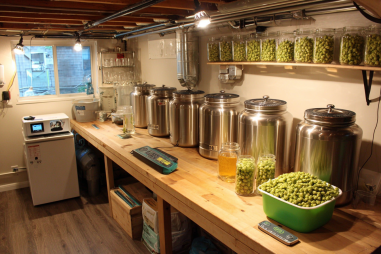American wheat beer has carved out a delightful niche within the vast world of craft beer, offering drinkers a refreshing and vibrant experience. Known for its smooth texture, approachable bitterness, and bright citrusy undertones, this style has become a favorite for those seeking something flavorful yet easy to enjoy. What exactly gives American wheat beers their signature taste, and how do they differ from other wheat beer styles worldwide? Let’s dive into the distinct flavor profile that makes this beer style so uniquely appealing.
Overview of American Wheat Beer Style
American wheat beer is a substyle of wheat beer that typically features a significant proportion of wheat malt alongside traditional barley malt. Unlike German or Belgian wheat beers that often emphasize specific yeast-driven flavors, American wheat tends to focus more on hop character and a clean, crisp finish. Brewed in various craft breweries across the United States, this style appeals to a wide audience due to its approachable flavor, lower bitterness compared to some ales, and a smooth mouthfeel. It’s often lighter in color and body, making it perfect for warm weather or casual drinking occasions.
Malt Characteristics and Wheat Contributions
The use of wheat malt is a defining trait of this beer style. Wheat adds a distinctive softness and creaminess to the body of the beer, contributing to its smooth and slightly silky texture. It also enhances the head retention, giving the beer a frothy and inviting appearance. In terms of flavor, wheat malt imparts subtle sweetness and a mild graininess that balances the hop bitterness.
Barley malt components provide the backbone of malt flavor with notes of light bread, biscuit, or cracker-like maltiness. The combination of barley and wheat malts creates a perfect platform for the hops and yeast to shine without overwhelming the palate with heavy malt sweetness.
Typical Hop Flavors and Bitterness Levels
One of the standout features of American wheat beers is their hop profile, which tends to be brighter and more assertive than that of European wheat beers. American hop varieties are commonly used, offering citrusy, piney, and floral aromas and flavors. These hop notes often complement the natural wheat malt sweetness by introducing lively bitterness and fresh, zesty character.
Bitterness levels in American wheat beers are usually moderate, allowing for a refreshing finish without harshness. The International Bitterness Unit (IBU) often ranges from 15 to 30, striking a balance that lends drinkability and a clean palate. The hops dominate more in aroma and flavor than in intense bitterness, making the beer vibrant and appealing to both hop lovers and those new to craft beer.
Yeast and Fermentation Impact on Aroma and Taste
The yeast strains used in American wheat beers generally differ from those in traditional German or Belgian styles. American ale yeast strains tend to produce a cleaner fermentation profile with fewer phenolic or spicy esters. This clean yeast character helps highlight the bright hop notes and malt sweetness, creating a more straightforward and crisp flavor profile.
Some brewers introduce subtle yeast-derived notes like faint fruitiness or mild breadiness, but overall, fermentation is geared toward clarity and smoothness. This approach makes the beer more accessible for a broad range of drinkers and enhances its refreshing qualities.
Common Flavor Notes: Citrus, Spice, Fruitiness
When tasting an American wheat beer, expect to encounter an enticing medley of flavors. Citrus is often the star, with grapefruit, lemon, lime, and orange peel notes frequently present due to the choice of hops. These bright flavors give the beer a sunny and invigorating character.
Alongside citrus, subtle spice notes may emerge from both the hops and yeast, hinting at flavors like coriander or pepper, though these are generally mild. Fruitiness can vary but often includes light melon, tropical fruits, or apple tones that add complexity without overwhelming the palate.
Combined, these elements produce a beer that is flavorful and nuanced but still smooth and refreshing, with a crisp finish that invites another sip.
Comparing Flavor Profiles with Other Wheat Beers
American wheat beers stand apart from other well-known wheat styles like German Hefeweizen or Belgian Witbier. Here’s how they compare:
- German Hefeweizen: Typically has pronounced banana and clove flavors from special yeast strains, with a creamy texture. The hop bitterness is generally very low.
- Belgian Witbier: Features strong citrus and spice notes from added ingredients like orange peel and coriander, combined with a slightly tart finish.
- American Wheat: Emphasizes brighter, cleaner hop bitterness with crisp citrus and mild malt sweetness, plus a more neutral yeast character.
This contrast highlights American wheat beer’s approachable but vibrant essence, making it a versatile brew that bridges the gap between malt sweetness and hop bitterness in a balanced way.
Food Pairings That Complement the Flavor
The flavor profile of American wheat beer makes it exceptionally food-friendly. Here are some great pairing suggestions:
- Grilled seafood: The beer’s citrus notes and crisp finish complement fish, shrimp, or scallops perfectly, especially when lightly seasoned.
- Fresh salads: Citrus and floral hop flavors enhance fresh greens and vinaigrettes without overpowering them.
- Spicy dishes: Whether it’s Mexican, Thai, or Cajun cuisine, the beer’s refreshing qualities can cool the palate and balance chili heat.
- Light cheeses: Soft cheeses like goat cheese or mozzarella pair well, as the beer’s mild malt sweetness offsets cheese richness.
- Barbecue chicken: The combination of malt and hops harmonizes with smoky and slightly sweet barbecue sauces.
Crafting Your Own Flavor Preferences
If you’re inspired to explore American wheat beers or even brew your own, consider how adjusting ingredients and methods can shape the flavor profile:
- Wheat malt percentage: Increasing wheat malt adds more body and smoothness, while lowering it might give a lighter mouthfeel.
- Hop varieties: Experiment with different American hops—like Cascade, Centennial, or Amarillo—to tweak citrus, floral, or pine flavors.
- Yeast strains: Selecting cleaner ale yeast keeps flavors crisp; introducing specialty yeast can add subtle fruity or spicy notes.
- Fermentation temperature: Higher temps encourage more ester development, enhancing fruitiness; cooler temps promote clean, bright finishes.
Adjusting these factors allows homebrewers and craft enthusiasts to tailor American wheat beer to personal taste preferences, making each brew unique yet still unmistakably vibrant and inviting.
Discovering the Joy of American Wheat Beer
American wheat beer is a shining example of how traditional brewing elements can be reinterpreted with a modern twist. Its bright citrus notes, balanced maltiness, and moderate hop bitterness create an inviting, versatile brew that suits a variety of occasions and palates. Whether you’re a seasoned beer lover or just beginning to explore craft styles, American wheat beer offers a flavorful yet approachable option bursting with refreshing character. So next time you’re looking for a lively, smooth beer, give this style a try—you might just find your new favorite!







